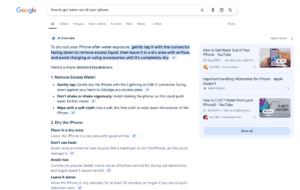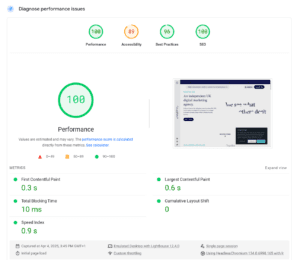
Are AI Overviews killing organic search?

AI Overviews have been dominating the SERPs for some time now, but the question on every SEO’s lips is still: ‘Are they killing organic search?’
While SEO experts have expressed differing opinions, there’s one thing that can’t be denied, and that’s the stats and data.
In this blog, you’ll find all the latest and most relevant stats related to Google’s AI Overview feature, as well as guidance on how to adapt your SEO strategy to keep up with your competitors in the ever-evolving search landscape.
Need help optimising your SEO content for AI Overviews? Get in touch to learn more about Embryo’s incredible client results.
What are AI Overviews and how do they work?
If you’ve Googled anything within the past few months, you’ve probably come across AI Overviews. This feature appears at the very top of the search engine results page (SERP) and provides you with a concise, AI-generated answer to your search query based on information taken from relevant online sources.

It typically consists of a brief summary followed by a more in-depth explanation, with the three main search results it got the information from displayed on the right hand side.
The AI analyses data from multiple sources, including web pages and Google’s Knowledge Graph, to create its summaries and make sure they’re as accurate as possible. Unlike featured snippets, which extract information from a single page, AI Overviews provide a broader overview of a topic, pulling the most relevant information from each page. Users can use the links to the sources to check where the information was sourced from or explore the topic further.
AI Overviews: Key stats that SEOs need to know
Because AI Overviews are still relatively new, new research is constantly being done. These are the most relevant stats as of April 2025:
- Organic CTRs drop from 1.41% to 0.64% on average when AI Overviews are present on the SERP, but increase when absent (source: Seer Interactive).
- When a brand appears within the AI Overview, organic CTRs increase from 0.74% to 1.02% on average (source: Seer Interactive).
- High-ranking organic search results are far more likely to appear as link cards in AI Overviews, with the #1 ranked organic result having a 55% greater chance of appearing than the #2 result (source: LinkedIn).
- In a Surfer SEO study, 52% of sources cited in the AI Overview ranked in the top 10 SERP results (source: Surfer SEO).
- AI Overviews mention the exact keyword only 5.4% of the time, meaning Google focuses on context over exact keyword matches (source: Surfer SEO).
- 96.5% of all AI Overviews appear for informational keywords, meaning very few overviews will pop up for transactional, navigational, and local search queries (source: SE Roundtable).
- According to a Semrush study, only 5% of SERPs with an AI Overview also featured PPC ads (source: Semrush).
- Tests by Google revealed that the accuracy rate of AI Overviews match that of featured snippets, which users generally consider to be reliable (source: Google).
- Semrush found that 82% of desktop and 76% of mobile AI Overviews occurred for keywords with less than 1000 monthly searches (source: Semrush).
- Linking can be extensive in AI Overviews, with up to 302 links being featured in a single overview (source: Semrush).
So, should SEOs be worried about AI Overviews killing organic search?

Most of the data suggests that SEOs don’t need to be particularly concerned about AI Overviews, as content that ranks in the top 10 SERP results is more likely to appear in the AI Overview anyway. However, this isn’t guaranteed, and SEO experts are still divided on just how detrimental AI Overviews are and will continue to be for businesses who have earned their place on the SERPs.

Amy Leach
Organic Lead
On the other hand, many users are still skeptical about AI Overviews, with many people skipping them or attempting to remove them from their search results altogether. This is hardly surprising given the number of errors displayed in the AI Overviews when the feature was first rolled out in 2024, recommending that people put glue on pizza and eat rocks, to name just two examples. Although Google has long since rectified this issue and AI Overviews are now accurate for the most part, the bad reputation is proving hard to shake. This is good news for SEOs though, as it means AI Overviews haven’t taken over the SERPs completely and users who don’t trust the feature will continue clicking through to the organic listings.
It seems safe to say that while AI Overviews aren’t ‘killing’ organic search completely, they do mark an end to organic search as we know it – although the extent to which this is true can’t be fully determined at this early stage of the feature’s existence. What we do know is that SEOs should no longer be concerned about just rankings – instead, they should focus on producing high-quality content that is likely to appear in the AI Overviews.
How can you get your content to appear in the AI Overview?
Fortunately, there’s a massive overlap between what makes content rank highly on the SERPs and what makes it appear in the AI Overview. This means if you’re already implementing SEO best practices in your content, maintaining the status quo is the best thing you can do.
However, if you’re struggling to see results from your existing content strategy and want to increase your chances of appearing in AI Overviews, make sure you’re doing the following:
1. Think about search intent
AI Overviews prioritise content that directly addresses the users queries, so make sure your content aligns with what users are actually looking for. This is known as aligning with search intent.

Shona Worsman
Content Lead
2. Prioritise readability
Another way to increase your chances of appearing in AI Overviews is thinking about the structure of your content. Use headings, bulletpoints, and tables to make your content scannable and easier to read.
Concise content that is easy for readers to digest is much more likely to appear in AI Overviews than long-winded content that doesn’t put the user -experience at the forefront.
3. Write original content
Google has always prioritised unique, high-quality content to ensure users are able to quickly find credible answers to their search queries, and the AI Overview is no different.
Simply rehashing the same information as your competitors is unlikely to get you a position in that top spot. Instead, think about what unique spin you can put on the topic that might make your blog stand out. This could be anything from gathering original expert quotes to creating original infographics.
Before you start writing, look at what’s already ranking on the SERP and think ‘how can I do this, but better?’
Never use AI for writing your content! AI rehashes content from existing sources and therefore is not original.
Leading on from our previous point, one of the best ways to make your content unique and trustworthy, and therefore more likely to appear in the AI Overview, is to include plenty of E-E-A-T elements.
E-E-A-T stands for Experience, Expertise, Authoritativeness, and Trustworthiness – the four things Google wants to see your content demonstrating to rank it highly on the SERPs and feature it in the AI Overview.
There are plenty of E-E-A-T elements you can incorporate into your content to make it more valuable:
- Expert quotes
- Videos and imagery
- Author bios
- Case studies
- Customer reviews
- References and citations
5. Create evergreen content
AI Overview prioritises content that is fresh and relevant, so it’s important none of the information on your website is out of date. One of the best ways to avoid outdated content is to create evergreen pieces; that is, content that will remain relevant long after it’s been written and doesn’t need frequently updating.
When it comes to content that will quickly become outdated, such as the latest statistics on a topic or developments in a certain sector, make sure you’re coming back and refreshing it regularly.
6. Focus on long-tail keywords
AI Overview also favours content that mirrors the natural, conversational language that you might use when talking to a friend, so make sure you’re targeting long-tail keywords.
Long-tail keywords are often in a question format, such as ‘How do I get water out of my iPhone?’ They’re the most likely type of search query to have an AI Overview. Because they’re fairly specific, they also tend to have a low search volume.
When answering the query in your content, use simple language and a conversational tone to give yourself the best chance of being featured in the AI Overview.
7. Leverage schema markup
Schema markup helps search engines understand your content better, and is crucial if you want your site to appear in the AI Overview.
Implement article schema for your blog content and FAQ schema to clearly signpost your answers to questions that users might ask to help Google read your content correctly and increase the chance of it appearing in AI Overviews.
8. Optimise page experience
Google will only direct traffic to your site via the AI Overview if your website is user-friendly. That means optimising the page experience by doing things like improving loading speed and ensuring your website is compatible with mobile.
You can use Google’s PageSpeed Insights to find out the current loading speed of your site and gain insights into changes that can be made to make it faster.

9. Incorporate images and videos
AI Overviews are more likely to pull content that includes images and videos. Include plenty of high-quality images and infographics in your blogs and make sure they’re optimised for SEO with alt text and captions.
Videos in particular help content feature in the AI Overview. Tutorials especially are increasingly featured in AI responses and are fairly easy for brands to film and upload.
10. Build your backlinks profile
Backlinks are one of Google’s top ranking factors because they essentially act as an endorsement of your content’s quality. To rank highly on the SERPs and appear in the AI Overview, you need to build a healthy backlink profile by engaging in link building.
Worried about AI Overviews affecting your rankings? Embryo can help
With so many elements to get right, writing high-quality, original content that ranks well can be a challenge. At Embryo, our team of content experts know exactly what it takes to create winning content.
Check out our range of case studies or get in touch to learn more about how Embryo can help your business to grow.




